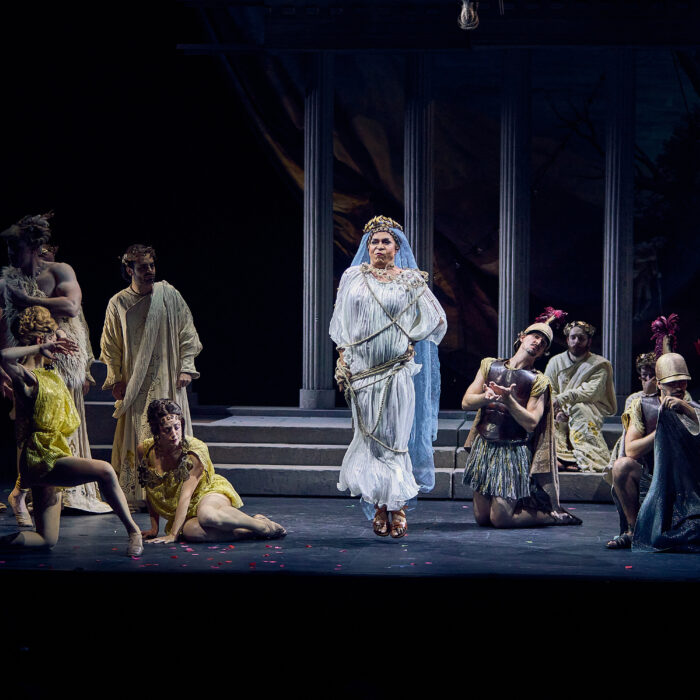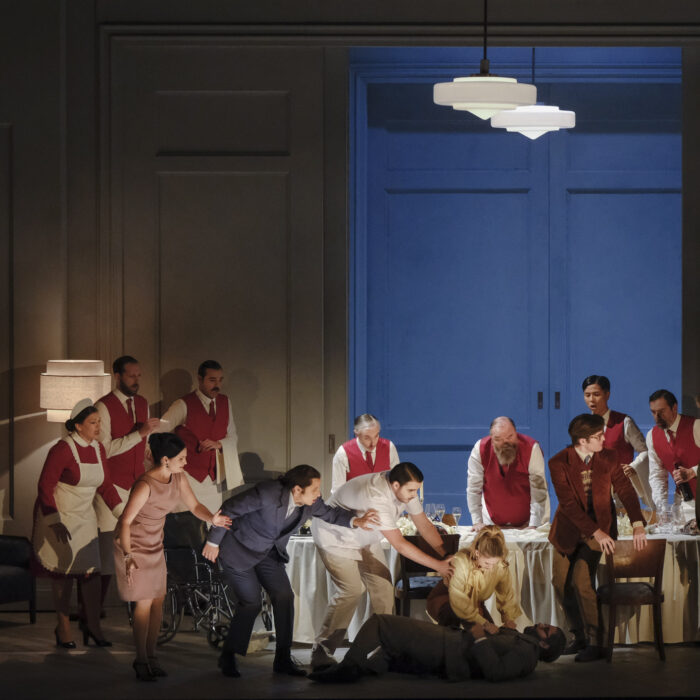
Salzburg Festival 2017 Review – Aida: Anna Netrebko, Riccardo Muti Create Glorious Music In Light of Pointless Production
By Yige LiSalzburg Festival is about luxury. The audience is filled with celebrities, the casts are filled with stars, and the (relatively) higher priced tickets, all show its luxury. Yet, what defines its luxury, for me, is its long rehearsal period. When Anna Netrebko said in an interview how she wanted more rehearsals and Riccardo Muti said “preparing an opera the way I insist on doing it is time-consuming,” explaining his limited opera engagements in recent years, it is telling that even in top houses, well-prepared performances are not always guaranteed.
That is not a problem in Salzburg. And one can hear it from the very first note to the last one.
Under the baton of maestro Muti, the Vienna Philharmonic played with sensitivity never overpowering the singers and always keeping a sturdy and incredibly balanced sound. One could single out any part to praise the virtuoso playing, yet it was the theatrical effect that defined the quality of the performance. How often does the opening prelude provide such a vivid atmosphere? One could envision the scene as the orchestra played in the dark cavernous theater. However, when the curtain actually went up one could not help but feel let down by the visual on stage. As a matter of fact, from the onset, it was obvious this production was really more of a pretty set with no point of view but more on that later. It was the orchestra that provided the real backdrop for the whole plot. One stand-out element among all was Muti’s pace control. Compared to his rendition from almost 40 years ago (various sources indicate that last time Muti conducted “Aida” was 1979), his 2017 interpretation used broader tempi with more refined and economic dynamic shiftings. It was slower only in a “stopwatch” sense, but a continued forward flow was always evident or, in Muti’s own words “even when there is only one repeated note, there should always be a sense of direction”. Another striking element was the orchestra’s involvement in the psychological expression of characters. Examples could be found throughout the performance and were most memorable during Act three when Aida sings the line “Padre, a costoro schiava non sono […] O patria! o patria…quanto mi costi!” finally making her decision to place duty above love. Here the violins began to weep, openly revealing all the inner feelings of the character.
While it was a relief to have such a great orchestra in the pit rather than a banda so often assigned to a Verdi opera, it also demanded the singers to be at the same level.
The Diva Dominates
In the title role, Anna Netrebko, who was making her role debut in this run of performances, was certainly up to the challenge. As with any role debut, audience members were wondering how the role would fit in her voice and how she would approach the character.
First, let’s discuss the vocal work. For anyone familiar with Netrebko’s recent vocal development, it would have been predictable that the role of Aida would be a great fit. Is she a dramatic soprano? No. Is she a spinto? Maybe–it depends on each one’s own definition of this vague term. The bottom line is she has a full lyric voice that is capable of soaring above orchestra and chorus, including the huge ensemble during the triumphal scene of Act two, which she noted in interviews could be the trickiest part. But from her low chest voice to the spinning high pianissimi, this one-register-like voice seemed to have no limit.
As for her characterization, Netrebko was fully committed to her role. Whereas other sopranos make you cry in the final tomb scene of final Act four, Netrebko ‘s Nile scene in Act three was the standout and made you tear up. Her duet with Amonasro was the climactic moment in her performance. When Aida comes to the realization that she’s going to have to cheat on her beloved, thus giving up trust, an essential element of love, Netrebko’s “pietà” was filled with desperation and the words turned to hollowness rather than sorrow. The intensity in her “O patria! o patria… quanto mi costi!”, continuously grew but eventually ended with calmed down fatalism in the repeating of “quanto mi costi.” It was a display of true vocal acting. As opposed to the fullness of heart we got here, in the following duet between Aida and Radames, it was only “half-hearted.” Ironically, during this duet when the two lovers finally get the chance to be together, rather than being a love duet one felt more like it was “cheat” duet (from Aida’s perspective, at least). Here, Netrebko sang with both aggression and caution, and occasionally blended some tiny flirting color into her singing. Yet, she imbued it with emotional complexity, the “cheating” color naturally slipping into dreaming or passionate colors more in line with the expectations of a true love duet, as if Aida was trapped into her own words as well and forgot all the calculations behind.
Muti’s Magical Troops
As Radamès, Francesco was also making his role debut. He, too, has worked with Muti frequently, and throughout the performance, his phrasing followed the maestro’s guidance closely. For those expecting a spinto sound, they did not get it. Meli’s timbre is that of a lyric tenor voice that while audible all the time thanks to his nice projection.But one has to admire his beautiful pianissimi particularly his B flat at the end of “Celeste Aida” and during “o terra addio.” And in his duets with Netrebko it was evident that both were on the same page creating vocal colors and providing subtle nuances in that sometimes are overlooked for load singing this work. In their Nile Scene duet, one recalled pure Bel canto singing that made the duet captivating. Character-wise, Meli fulfilled the charming lover side of Radamès nicely, but one did not come away feeling that he was the captain who leads the army of a country.
In the relatively short but important role of Amonasro, Luca Salsi contributed to creating a riveting and climactic Nile scene. He is a frequent collaborator with Maestro Muti, and it showed in his singing. Whether he sang with a low-voice whisper with pauses or loud cursing vigor, his pacing was always well-synchronized with the Orchestra under Muti’s baton. At the end of Act two, he also provided a heroic vocal quality that allowed audiences to see the warrior.
An Unexpected Absence
Unfortunately, the originally scheduled Amneris, Ekaterina Semenchuk was ill. As noted at the start of this review, long rehearsal periods are essential to the high quality that Salzburg Festival could provide. Thus, missing an original cast member could cost more than the usual in normal opera houses. Not having alternate casts is often times a detriment to the overall production and there was no cover for Amneris. Luckily, Daniela Barcellona was brought in and arrived in Salzburg at 2 p.m. that afternoon. The lucky part was that she is also a frequent collaborator with Maestro Muti and being familiar with Muti’s style was crucial. With a short piano rehearsal with Muti, she provided the best result one would expect under such situation. Having a relatively soft voice, Barcellona built a more girlish Amneris (as compared to Semenchuk), while not short on passion.
No Experience & It Shows
Maybe I should say it is great that there was almost no staging for this new production which certainly made a jump-in easy. It is hard to understand the decision to bring in someone with not just zero experience of staging opera, but even almost no experience with opera. Staging opera does not only need some genius idea, which director Shirin Neshat might indeed have based on her talk about the production, but also the craftsmanship. Without craftsmanship, what we saw was a chorus standing like in an oratorio and soloists left alone to move with no apparent direction.
What made this production so ineffective was the fact that it did not seem like Neshat had any new ideas about the characters. The movements and gestures all seemed like they came from any old “Aida” production. The Triumphal March showcased a microwave-shaped stage moving around on a turntable, ultimately revealing nothing. Dancers moved about without a true discernible purpose. The same could be said for the projections, which came up every once in with no real effect or any revealing information. They seemed like an add-on and a visual ploy for a production that was already bland and without a real point of view.
I won’t deny we need more diverse voices in opera directing but I would suggest the best way is supporting the youth and waiting for them to grow. Grabbing some established artist in other fields to build up diversity in opera is a lazy and an ineffective solution.
Still, “a concert version with costumes” has more theater than a pure concert version opera performance. Thankfully, the production couldn’t hurt the music being made particularly with Muti’s sui generis music-making. Perhaps next time, it would be a better idea to just bring in some dusty general sets and costumes and have a opera director who can build up real interpersonal regie? As for Anna Netrebko, one of the best singing actress currently in the business, one hopes she gets a more insightful production next time. On the account of her first interpretation, she certainly deserves it.


